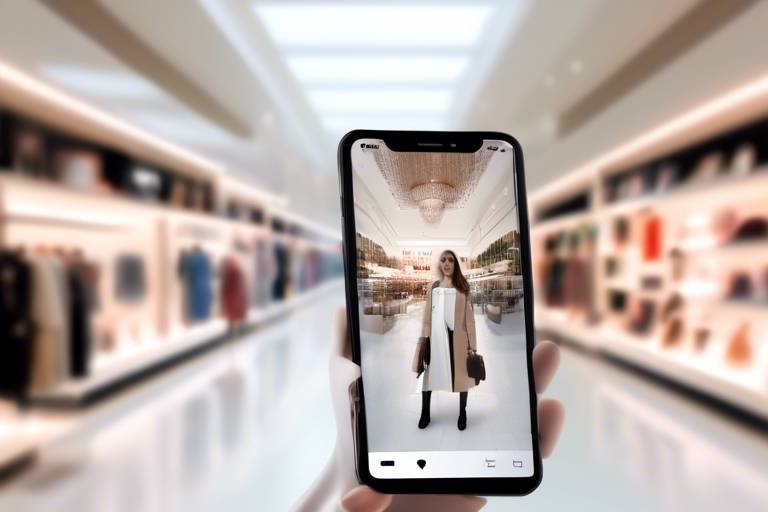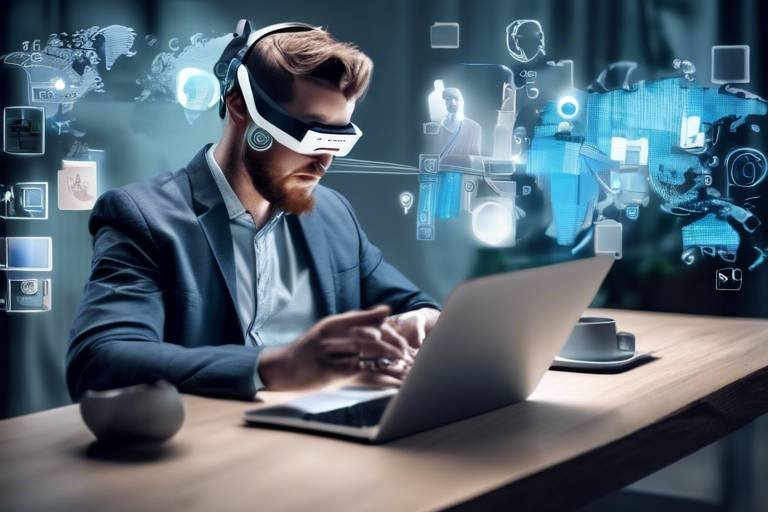How AI Will Revolutionize Retail Shopping Experiences
The retail landscape is undergoing a seismic shift, and at the heart of this transformation is artificial intelligence (AI). Imagine walking into a store where every product seems to have been handpicked just for you. Sounds like a dream, right? Well, this is the reality that AI is crafting for shoppers today. By harnessing the power of data and machine learning, retailers are not just enhancing the shopping experience; they are completely redefining it. From personalized recommendations to streamlined checkout processes, AI is making shopping more convenient, efficient, and enjoyable than ever before.
Think about your last shopping experience. Was it tailored to your specific needs? Did you feel like the products were curated just for you? With AI, retailers can analyze individual preferences and shopping behaviors to create a unique shopping journey for each customer. This means that the more you shop, the better your experience becomes. It’s like having a personal shopper who knows you inside out—one that never gets tired or makes mistakes.
But it doesn't stop there. AI is also revolutionizing how retailers manage their inventory. Gone are the days of overstocked shelves and empty aisles. With predictive analytics, retailers can anticipate customer needs and trends, ensuring that the right products are available at the right time. Imagine a world where your favorite snack is always in stock, and you never have to face the disappointment of an empty shelf. This is the future that AI is paving the way for.
Additionally, AI-driven systems can automate restocking processes. This means that retailers can focus on what really matters—delivering exceptional customer service—while AI handles the logistics behind the scenes. Picture this: you’re in a store, and you notice that the popular items are constantly replenished without any human intervention. This not only enhances customer satisfaction but also boosts sales as customers find what they want, when they want it.
Furthermore, customer service is getting a major upgrade thanks to AI. With AI-powered chatbots and virtual assistants available 24/7, customers can get answers to their queries and resolve issues quickly. No more waiting in long lines or being put on hold for what feels like an eternity. This instant support fosters a sense of trust and reliability, making customers feel valued and understood.
Imagine having a virtual shopping assistant that guides you through your shopping journey, offering product information and personalized recommendations based on your preferences. This is not a scene from a sci-fi movie; it's happening right now! AI tools can even analyze customer feedback and sentiment, allowing retailers to adapt their strategies and improve services based on real-time insights. This level of responsiveness is a game-changer in the retail world.
Let's not forget about the checkout process. AI simplifies this experience through technologies like facial recognition and mobile payments, drastically reducing wait times and enhancing customer convenience. Picture walking into a store, grabbing what you need, and simply walking out—your payment processed seamlessly without a single interaction. This is the convenience that AI brings to the table, making shopping not just easier, but also more enjoyable.
As we look towards the future, the trends in retail AI promise even more exciting developments. From augmented reality shopping experiences that allow customers to visualize products in their own space, to AI-driven supply chain management that enhances logistics efficiency and reduces costs, the possibilities are endless. Retailers who embrace these technologies will not only stay ahead of the curve but will also create shopping experiences that are truly unforgettable.
In conclusion, AI is not just a tool but a revolution that is changing the way we shop. It’s about creating a more personalized, efficient, and enjoyable experience for customers. As technology continues to evolve, we can only imagine how much further AI will take us in the retail space. So, are you ready to embrace the future of shopping?
- How does AI personalize shopping experiences?
AI analyzes customer data, preferences, and shopping behaviors to deliver tailored recommendations, making each shopping experience unique.
- What role does AI play in inventory management?
AI predicts demand patterns, automates restocking, and helps retailers maintain optimal inventory levels, ensuring that popular items are always available.
- Can AI improve customer service?
Yes! AI-powered chatbots and virtual assistants provide 24/7 support, answering queries and resolving issues quickly, enhancing customer satisfaction.
- What are the benefits of AI in checkout processes?
AI streamlines checkout with technologies like facial recognition and mobile payments, reducing wait times and improving convenience for shoppers.
- What future trends can we expect from AI in retail?
We can expect innovations like augmented reality shopping and AI-driven supply chain management, which will further enhance the retail experience.

Personalized Shopping Experiences
The world of retail is undergoing a seismic shift, and at the heart of this transformation is artificial intelligence. Imagine walking into a store where every product recommendation feels like it was handpicked just for you. That’s the magic of AI! By analyzing your individual preferences and shopping behaviors, AI enables retailers to create a unique shopping journey for each customer. It’s almost like having a personal shopper available at all times, ready to cater to your needs.
AI systems can sift through vast amounts of data, identifying patterns that may not be immediately apparent to human eyes. For instance, if you frequently purchase fitness gear, AI can suggest the latest running shoes or workout apparel that align with your style. This level of personalization not only enhances customer satisfaction but also fosters a deeper connection between the consumer and the brand. Retailers are now able to engage with customers on a more personal level, making the shopping experience feel less transactional and more like a relationship.
Furthermore, AI can anticipate your needs before you even realize them. Let’s say you always buy a new phone case every time you upgrade your phone. AI can analyze your past purchase history and notify you when new cases that fit your model are available. This proactive approach to shopping means that customers are more likely to find what they want without the hassle of searching through countless options. In fact, studies show that personalized recommendations can increase sales by up to 300%! It’s a win-win situation for both retailers and consumers.
Moreover, the integration of AI in retail isn’t just about recommendations; it extends to personalized marketing strategies as well. Retailers can send tailored promotions and discounts to customers based on their previous purchases or browsing history. Imagine receiving a special offer on your favorite brand of sneakers just when you’re considering a new pair! This targeted approach not only drives sales but also enhances customer loyalty, as consumers appreciate brands that understand their preferences.
To further illustrate the impact of personalized shopping experiences, consider the following table that outlines the benefits of AI-driven personalization:
| Benefit | Description |
|---|---|
| Increased Customer Satisfaction | Personalized recommendations make shopping easier and more enjoyable. |
| Higher Conversion Rates | Tailored suggestions lead to increased sales and customer engagement. |
| Improved Customer Loyalty | Customers are more likely to return to brands that cater to their preferences. |
| Enhanced Brand Image | Brands that utilize AI for personalization are seen as innovative and customer-centric. |
In conclusion, the integration of AI into retail is not just a trend; it is a fundamental shift towards a more personalized shopping experience. As technology continues to evolve, retailers who embrace these changes will not only enhance customer satisfaction but also secure their place in the future of retail. The question is, are you ready to embrace a shopping experience that feels tailor-made just for you?
- How does AI personalize shopping experiences?
AI analyzes customer data, including past purchases and browsing behavior, to make tailored recommendations. - Can AI predict what I want to buy?
Yes! AI uses predictive analytics to anticipate customer needs based on historical data. - What are the benefits of personalized shopping?
Benefits include increased customer satisfaction, higher conversion rates, and improved loyalty. - How do retailers use AI in marketing?
Retailers use AI to send targeted promotions and discounts based on individual customer preferences.

Inventory Management Optimization
In the bustling world of retail, where customer preferences can shift like sand, inventory management has become a critical component of success. Enter artificial intelligence (AI)—the game changer that is revolutionizing how retailers manage their stock. With AI-driven systems, retailers can now predict demand patterns with remarkable accuracy, allowing them to maintain optimal inventory levels. Imagine a world where overstock is a thing of the past, and customers find exactly what they want, when they want it. Sounds like a dream, right? Well, it's becoming a reality!
One of the most exciting aspects of AI in inventory management is its ability to leverage predictive analytics. This technology analyzes historical sales data, market trends, and even external factors like weather or local events to forecast demand. By understanding these patterns, retailers can make informed decisions about what products to stock and when. For example, if data shows that certain items sell better during the holiday season, retailers can adjust their inventory accordingly, ensuring they are well-prepared for the influx of customers.
Moreover, AI can take this a step further with automated restocking processes. Imagine walking into a store and seeing shelves perfectly stocked with your favorite items. AI can monitor inventory levels in real-time and automatically trigger restocking orders when items fall below a certain threshold. This not only enhances customer satisfaction but also maximizes sales opportunities. No more lost sales due to empty shelves!
| Benefits of AI in Inventory Management | Description |
|---|---|
| Improved Forecasting | AI analyzes data to predict demand more accurately, reducing the chances of overstock and stockouts. |
| Cost Efficiency | By optimizing inventory levels, retailers can reduce storage costs and minimize waste. |
| Enhanced Customer Experience | With the right products available at the right time, customers are more likely to have a positive shopping experience. |
In conclusion, the integration of AI in inventory management is not just a trend; it's a necessity for retailers aiming to thrive in today's competitive market. By harnessing the power of predictive analytics and automated processes, businesses can ensure they meet customer demands efficiently and effectively. As we move forward, it's clear that the future of retail will be shaped by these intelligent systems, paving the way for a shopping experience that is not only seamless but also incredibly satisfying for consumers.
- How does AI improve inventory management? AI improves inventory management by predicting demand patterns, automating restocking, and providing real-time data analysis.
- What are the benefits of using predictive analytics in retail? Predictive analytics helps retailers anticipate customer needs, optimize stock levels, and enhance overall operational efficiency.
- Can AI help reduce costs in inventory management? Yes, by optimizing inventory levels and minimizing overstock and waste, AI can significantly reduce costs associated with inventory management.

Predictive Analytics
Predictive analytics is like having a crystal ball for retailers, providing insights that can significantly shape their strategies and operations. By leveraging historical data, machine learning algorithms, and statistical techniques, retailers can forecast customer behavior, demand trends, and even market shifts. Imagine being able to predict what your customers will want before they even know it themselves! This capability not only enhances inventory management but also allows for more effective marketing strategies.
For instance, retailers can analyze past purchasing patterns to determine which products are likely to be in demand during specific seasons or events. This means they can stock up on popular items before they fly off the shelves, minimizing the risk of stockouts or overstock situations. Think of it as preparing your favorite dish ahead of time for a party—you want to make sure you have enough ingredients without ending up with leftovers!
Moreover, predictive analytics empowers retailers to segment their customers more effectively. By understanding the preferences and behaviors of different consumer groups, businesses can tailor their offerings and marketing messages. For example, a clothing retailer might discover that a particular demographic prefers eco-friendly materials. Armed with this knowledge, they can create targeted campaigns that resonate with those values, enhancing customer engagement and loyalty.
Here's a simple illustration of how predictive analytics works in retail:
| Data Source | Analysis Type | Outcome |
|---|---|---|
| Past Sales Data | Trend Analysis | Forecast future demand for specific products |
| Customer Feedback | Sentiment Analysis | Identify areas for product improvement |
| Market Trends | Competitive Analysis | Adjust pricing strategies accordingly |
In summary, predictive analytics is a game-changer in the retail landscape. It allows businesses to not only react to market changes but also to proactively shape their strategies. By anticipating customer needs and preferences, retailers can create a more personalized shopping experience that not only meets but exceeds customer expectations.
- What is predictive analytics? Predictive analytics involves using historical data and statistical algorithms to forecast future outcomes, helping retailers make informed decisions.
- How does predictive analytics benefit retailers? It helps retailers optimize inventory, tailor marketing strategies, and enhance customer satisfaction by anticipating needs.
- Can small retailers use predictive analytics? Absolutely! With the right tools and data, even small retailers can leverage predictive analytics to improve their operations.

Automated Restocking
Imagine walking into your favorite store, and every shelf is perfectly stocked with the items you love. Sounds like a dream, right? Well, thanks to powered by artificial intelligence, this dream is becoming a reality. Retailers are now leveraging AI to streamline their restocking processes, ensuring that shelves are always filled with the products customers want. This technology not only enhances customer satisfaction but also significantly boosts sales by minimizing the chances of stockouts.
So, how does automated restocking work? At its core, it involves the use of sophisticated algorithms that analyze sales data and inventory levels in real-time. By keeping a close eye on which items are flying off the shelves and which are gathering dust, retailers can make informed decisions about when to reorder stock. This predictive capability is akin to having a crystal ball that forecasts demand, allowing businesses to stay one step ahead.
Moreover, automated restocking systems can be integrated with IoT devices (Internet of Things), such as smart shelves that monitor inventory levels. These devices can send alerts when stock is running low, triggering automatic orders to suppliers. This not only saves time but also reduces the likelihood of human error, which can lead to overstocking or understocking. The efficiency of this system means that retailers can focus on other critical aspects of their business, such as enhancing customer experience and improving marketing strategies.
To give you a clearer picture, here’s a simple breakdown of how automated restocking works:
| Step | Description |
|---|---|
| 1 | Data Collection: Sales data is collected from various channels. |
| 2 | Analysis: AI analyzes this data to identify trends and predict future demand. |
| 3 | Inventory Monitoring: Smart shelves monitor stock levels in real-time. |
| 4 | Automatic Reordering: When stock levels fall below a certain threshold, orders are placed automatically. |
In addition to enhancing customer satisfaction by ensuring that popular items are always available, automated restocking also helps retailers manage their inventory more effectively. This means less waste, as products are less likely to expire or become outdated on the shelves. Ultimately, the integration of AI in restocking processes is a game-changer for the retail industry, leading to increased efficiency, reduced costs, and a more enjoyable shopping experience for consumers.
- What is automated restocking? Automated restocking refers to the use of AI and technology to manage inventory levels and reorder products automatically based on sales data.
- How does AI help in restocking? AI analyzes sales trends and inventory levels to predict when products need to be reordered, ensuring shelves are always stocked with popular items.
- What are the benefits of automated restocking? The benefits include reduced stockouts, improved customer satisfaction, less waste, and enhanced operational efficiency.
- Can automated restocking integrate with existing systems? Yes, most automated restocking solutions can integrate with current inventory management systems for seamless operation.

Enhanced Customer Service
In today's fast-paced retail environment, customer service can make or break a brand. With the integration of artificial intelligence (AI), retailers are not only improving their customer service but are also redefining what it means to provide exceptional support. Imagine walking into a store and having a virtual assistant greet you, ready to answer your questions and guide you through your shopping experience. This is the future that AI is ushering in, transforming how we interact with brands.
One of the most significant advancements in this area is the use of AI-powered chatbots. These virtual assistants operate around the clock, providing instant responses to customer inquiries. Whether it's a question about product availability or a request for help with an order, chatbots are designed to handle a multitude of queries without the need for human intervention. This not only reduces wait times but also ensures that customers receive timely assistance, enhancing their overall shopping experience.
Furthermore, AI can analyze customer interactions and feedback through sentiment analysis. This technology allows retailers to gauge customer emotions and satisfaction levels in real-time. For instance, if a customer leaves a review expressing frustration about a product, AI systems can flag this feedback and alert the customer service team to take immediate action. By understanding customer sentiment, retailers can adapt their strategies, resolve issues proactively, and ultimately foster deeper relationships with their customers.
Another exciting development is the concept of virtual shopping assistants. These AI-driven tools can guide customers through their shopping journey, offering personalized recommendations based on previous purchases and browsing history. Imagine having a personal shopper who knows your style and preferences, suggesting items that you might have overlooked. This level of personalization not only enhances the shopping experience but also increases the likelihood of conversion, as customers feel more connected to the products being offered.
In addition to these advancements, AI can also assist in training customer service representatives. By analyzing common customer queries and interactions, AI can identify knowledge gaps and suggest training modules to improve staff performance. This ensures that human agents are well-equipped to handle complex issues that require a personal touch, creating a seamless blend of human and AI support.
As we look to the future, it's clear that AI will continue to play a pivotal role in enhancing customer service in retail. The combination of automation and personalization not only streamlines operations but also creates a more engaging shopping experience for customers. With AI, retailers can anticipate needs, respond swiftly to inquiries, and provide tailored solutions that resonate with individual shoppers. The result? A retail landscape where exceptional customer service is not just a goal but a standard.
- What is an AI-powered chatbot?
A chatbot is a software application that uses AI to simulate human conversation and provide instant responses to customer queries. - How does sentiment analysis work?
Sentiment analysis uses natural language processing to analyze customer feedback and determine the emotional tone behind it. - Can AI improve customer service training?
Yes, AI can analyze customer interactions to identify areas where customer service representatives may need additional training. - What are virtual shopping assistants?
These are AI-driven tools that guide customers through their shopping journey, offering personalized recommendations based on their preferences.

Virtual Shopping Assistants
Imagine walking into a store where a friendly assistant greets you by name, knows your preferences, and suggests products tailored just for you. This isn’t a scene from a futuristic movie; it’s the reality brought to life by . These AI-powered tools are transforming the retail landscape by providing a personalized shopping experience that resonates with today’s tech-savvy consumers.
Virtual shopping assistants utilize advanced algorithms and machine learning to analyze customer data, enabling them to understand individual shopping habits and preferences. This means that when you log into an online store, the assistant can offer you recommendations based on your previous purchases, items you’ve browsed, and even trends that align with your style. This level of personalization not only enhances the shopping experience but also builds a stronger connection between the customer and the brand.
Furthermore, these virtual assistants are available 24/7, offering support whenever customers need it. Whether it’s answering questions about product specifications, helping with size selections, or providing information on shipping options, they ensure that assistance is always just a click away. This constant availability significantly reduces the frustration often associated with shopping, particularly during peak hours when human staff may be overwhelmed.
To illustrate how virtual shopping assistants work, consider the following functionalities:
- Product Discovery: They can help customers discover new products that fit their style and needs.
- Real-Time Assistance: If a customer has a question about a product, the assistant can provide immediate answers, enhancing the shopping experience.
- Personalized Promotions: They can alert customers to special offers or discounts that match their interests, encouraging purchases.
As we move forward, the integration of virtual shopping assistants will likely become even more sophisticated. With advancements in natural language processing and machine learning, these assistants will not only understand what customers are saying but will also be able to engage in meaningful conversations, making the shopping experience feel more human. Imagine asking your virtual assistant for outfit suggestions for an upcoming event and receiving tailored recommendations, complete with links to purchase the items directly.
In conclusion, virtual shopping assistants are not just a passing trend; they represent a significant shift in how we approach retail shopping. By combining technology with a personal touch, they enhance customer satisfaction and loyalty, making shopping more enjoyable and efficient. As retailers continue to adopt these innovative tools, we can expect a future where shopping is not only about purchasing products but also about enjoying a seamless and personalized experience.
Q1: What exactly is a virtual shopping assistant?
A virtual shopping assistant is an AI-powered tool that helps customers during their shopping journey by providing personalized recommendations, answering questions, and assisting with various tasks related to shopping.
Q2: How do virtual shopping assistants personalize my shopping experience?
They analyze your shopping history, preferences, and behaviors to offer tailored product suggestions and relevant information, making your shopping experience unique to you.
Q3: Are virtual shopping assistants available at all times?
Yes, one of the key benefits of virtual shopping assistants is their 24/7 availability, allowing customers to get assistance whenever they need it.
Q4: Can virtual shopping assistants understand natural language?
Yes, many virtual shopping assistants are equipped with natural language processing capabilities, allowing them to understand and respond to customer inquiries in a conversational manner.

Sentiment Analysis
In today's fast-paced retail environment, understanding customer sentiment is more crucial than ever. leverages the power of artificial intelligence to sift through mountains of customer feedback, reviews, and social media interactions. Imagine having a super-intelligent assistant that can read between the lines of customer comments, picking up on emotions and opinions that could easily be missed by human eyes. This technology helps retailers not only gauge how their products are perceived but also adapt their strategies in real-time.
By employing sentiment analysis, retailers can identify trends and patterns in customer feedback, allowing them to make informed decisions that enhance the shopping experience. For instance, if a particular product receives a wave of negative feedback, retailers can quickly address the issue, whether it’s a faulty item or poor customer service. This proactive approach not only helps in damage control but also builds trust with customers, showing them that their opinions matter.
Furthermore, sentiment analysis can be broken down into several key components:
- Emotion Detection: AI algorithms can categorize sentiments into emotions like happiness, anger, or frustration, providing deeper insights into customer feelings.
- Trend Identification: By analyzing sentiment over time, retailers can spot emerging trends that may influence future marketing strategies.
- Competitive Analysis: Understanding how customers feel about competitors’ products can help retailers position themselves more effectively in the market.
Imagine walking into a store where the staff is not only aware of your previous purchases but also understands how you felt about them. That’s the power of sentiment analysis in retail. It transforms the shopping experience from a transactional interaction into a personalized journey where customers feel valued and understood. As AI continues to evolve, we can expect sentiment analysis to become even more sophisticated, enabling retailers to tailor their offerings in ways we can only begin to imagine.
- What is sentiment analysis? Sentiment analysis is a technique used to determine the emotional tone behind a series of words, helping businesses understand customer sentiments based on feedback.
- How does sentiment analysis benefit retailers? It allows retailers to identify customer feelings towards products and services, enabling them to make informed decisions to enhance customer satisfaction.
- Can sentiment analysis predict future trends? Yes, by analyzing historical data, sentiment analysis can help retailers anticipate future consumer behavior and preferences.

Streamlined Checkout Processes
In the fast-paced world of retail, are becoming a game changer. Imagine walking into a store, grabbing what you need, and simply walking out without the hassle of waiting in long lines. Thanks to artificial intelligence, this vision is quickly becoming a reality. AI technologies are simplifying the checkout experience, making it not only faster but also more secure and convenient for consumers.
One of the most exciting advancements in this area is the integration of facial recognition technology. With this innovation, customers can check out just by looking at a camera. This not only speeds up the process but also enhances security, as it minimizes the chances of identity theft. Furthermore, mobile payment solutions have taken convenience to the next level. Customers can now pay for their items using their smartphones with just a tap, eliminating the need for cash or cards entirely.
Here's a quick overview of how AI is revolutionizing checkout processes:
- Contactless Payment Solutions: These options, powered by AI, allow for quick and secure transactions. Customers can make payments without physical contact, enhancing safety during shopping.
- Fraud Detection: AI algorithms continuously monitor transactions for any unusual activity. This proactive approach helps in detecting and preventing fraudulent purchases, thereby protecting both retailers and customers.
- Seamless Integration: AI systems integrate with existing point-of-sale systems, ensuring that the transition to a streamlined checkout process is smooth and efficient.
Moreover, the implementation of AI-driven checkout solutions has shown to significantly reduce wait times. Imagine a scenario where you can walk into a store, grab a few items, and leave in mere minutes. This not only enhances customer satisfaction but also encourages more frequent visits. Retailers are learning that a happy customer is a loyal customer, and streamlining the checkout process is a key component of that happiness.
As we look to the future, the potential for further advancements in checkout technology is immense. With ongoing developments in AI, we can expect even more innovative solutions that will continue to enhance the shopping experience. Retailers that embrace these technologies will not only improve their operational efficiency but also foster a more enjoyable and secure shopping environment for their customers.
Q: How does AI improve the checkout process?
A: AI enhances the checkout process by implementing technologies like facial recognition and mobile payments, which speed up transactions and improve security.
Q: Are contactless payments safe?
A: Yes, contactless payments are generally considered safe. AI algorithms monitor transactions for any unusual activity, helping to prevent fraud.
Q: Will AI take over all checkout processes in the future?
A: While AI will significantly enhance checkout processes, human oversight will still be essential for managing complex situations and ensuring customer satisfaction.

Contactless Payment Solutions
In today's fast-paced world, have emerged as a game-changer for both retailers and consumers. Imagine walking into a store, grabbing what you need, and simply tapping your phone or card at the checkout. Sounds like a dream, right? Well, it's a reality that's reshaping the retail landscape! These solutions not only enhance the shopping experience by making transactions quicker and more convenient, but they also add an extra layer of security that traditional methods can't match.
So, how exactly do contactless payments work? They utilize Near Field Communication (NFC) technology, allowing devices to communicate when they're in close proximity. This means that customers can complete transactions in mere seconds, reducing the time spent in line and enhancing overall customer satisfaction. Retailers are taking notice of this trend, as shorter wait times translate to happier customers and potentially higher sales.
Moreover, the rise of mobile wallets like Apple Pay, Google Pay, and Samsung Pay has made it even easier for consumers to adopt contactless payments. These wallets store multiple payment methods securely, allowing shoppers to leave their physical cards at home. The convenience of just tapping a device to pay is not only appealing but also aligns perfectly with the increasing demand for seamless shopping experiences.
There are several benefits to implementing contactless payment solutions in retail, including:
- Speed: Transactions are completed in seconds, which helps reduce long lines and waiting times.
- Security: Contactless payments often use tokenization and encryption, making them less susceptible to fraud compared to traditional card swipes.
- Customer Preference: As consumers become more tech-savvy, they increasingly prefer payment methods that are quick and easy to use.
Furthermore, retailers that adopt these technologies can gather valuable data on customer spending habits. This data can be analyzed to enhance marketing strategies and improve inventory management. For example, by understanding which products are frequently purchased together, retailers can optimize their layouts and promotions, ultimately driving more sales.
As we look to the future, the integration of contactless payment solutions is expected to grow even further. With advancements in technology, we might soon see features like biometric authentication, where customers can pay using their fingerprints or facial recognition. This would not only streamline the payment process but also enhance security even more.
In conclusion, contactless payment solutions are revolutionizing the retail experience by offering speed, security, and convenience. As retailers continue to embrace this technology, customers can look forward to a more efficient and enjoyable shopping journey.
- What is a contactless payment? A contactless payment is a secure method of payment that allows consumers to make purchases by simply tapping their card or mobile device near a point-of-sale terminal.
- Are contactless payments safe? Yes, contactless payments use encryption and tokenization to protect your financial information, making them a secure option for transactions.
- Do I need to have a special card for contactless payments? Not necessarily. Many debit and credit cards now come with contactless technology, and you can also use mobile wallets on your smartphone.
- Can I use contactless payment for online purchases? While contactless payments are primarily used in physical stores, some mobile wallets allow you to make online purchases securely.

Fraud Detection
In the fast-paced world of retail, ensuring customer safety is paramount. powered by artificial intelligence (AI) is a game-changer, acting like a vigilant security guard for online transactions. Imagine walking into a store and having a personal security expert who knows the ins and outs of fraudulent activity—this is what AI does for retailers. It continuously monitors transactions, analyzing patterns and flagging any unusual behavior that could indicate fraud.
AI algorithms are designed to sift through mountains of data in real-time. They look for anomalies, such as transactions that deviate from typical customer behavior. For instance, if a customer who usually makes small purchases suddenly attempts to buy a high-ticket item, the system can trigger an alert. This proactive approach not only protects the retailer but also enhances the customer experience by preventing unauthorized transactions.
Furthermore, AI can learn from past experiences. By utilizing machine learning, these systems continuously improve their detection capabilities. They adapt to new fraud tactics as they emerge, ensuring that retailers stay one step ahead of fraudsters. This is especially crucial in today's digital landscape, where fraud techniques evolve rapidly. The result? A significant reduction in fraudulent activities, leading to increased trust and loyalty from customers.
To illustrate the effectiveness of AI in fraud detection, consider the following table that outlines the traditional methods versus AI-driven approaches:
| Method | Traditional Approach | AI-Driven Approach |
|---|---|---|
| Speed | Slow, often manual reviews | Real-time monitoring and alerts |
| Accuracy | Higher false positives, requiring manual checks | Lower false positives, learning from data |
| Adaptability | Static rules, less responsive to new threats | Dynamic learning, adapts to new fraud patterns |
| Cost | Higher operational costs due to manual labor | Reduced costs through automation |
In summary, AI-driven fraud detection is not just an enhancement; it's a necessity in the modern retail environment. By leveraging these technologies, retailers can significantly mitigate risks associated with fraud while providing a seamless shopping experience for their customers. The future of retail is not only about selling products but also about creating a safe and trustworthy shopping environment.
- How does AI detect fraud in real-time?
AI uses algorithms to analyze transaction data and identify patterns that indicate potential fraudulent activity. - What happens when a transaction is flagged as suspicious?
The retailer can either reject the transaction, request additional verification from the customer, or conduct a manual review. - Can AI adapt to new fraud tactics?
Yes, AI systems use machine learning to continuously improve their detection capabilities based on new data and emerging fraud techniques. - Is AI fraud detection cost-effective?
Absolutely! While there may be initial setup costs, AI reduces operational costs by minimizing manual reviews and improving accuracy.

Data-Driven Marketing Strategies
In today's fast-paced retail environment, understanding your customer is more crucial than ever. This is where come into play. By leveraging artificial intelligence (AI), retailers can sift through mountains of data to uncover insights that drive effective marketing campaigns. Imagine being able to predict what your customers want before they even know it themselves! This is not just a dream—it's a reality that AI is making possible.
One of the primary benefits of data-driven marketing is the ability to create targeted campaigns. AI analyzes customer data, such as purchase history, browsing behavior, and even social media interactions, to segment audiences into distinct groups. This means that rather than sending out generic advertisements to everyone, retailers can tailor their messages to resonate with specific demographics. For example, a retailer might discover that young adults prefer eco-friendly products, allowing them to craft a campaign that speaks directly to this audience's values.
Moreover, AI can enhance the effectiveness of these campaigns by determining the optimal time to reach each segment. By analyzing when customers are most likely to engage with marketing content, retailers can schedule their outreach for maximum impact. This level of precision not only improves customer engagement but also significantly boosts conversion rates. Imagine sending a promotional email right when your customer is most likely to be online and ready to shop—this is the power of data-driven marketing!
| Marketing Strategy | Description | Benefits |
|---|---|---|
| Customer Segmentation | Dividing customers into groups based on shared characteristics. | Increased relevance of marketing messages. |
| Predictive Analytics | Using historical data to predict future customer behavior. | Improved decision-making and strategy formulation. |
| Dynamic Pricing | Adjusting prices based on demand and customer behavior. | Maximized sales and profitability. |
Another fascinating aspect of AI in marketing is the implementation of dynamic pricing models. These algorithms analyze various factors, including competitor pricing, demand fluctuations, and even customer behavior, to adjust prices in real-time. This means that a product might be priced differently depending on who is viewing it and when. For retailers, this strategy can lead to increased sales and enhanced customer satisfaction as they feel they are getting the best deal available.
Finally, the insights gained from AI-driven data analysis can also inform product development and inventory decisions. By understanding what products are trending and which ones are falling out of favor, retailers can make informed decisions about what to stock and promote. This not only optimizes inventory but also aligns product offerings with customer desires, creating a win-win situation for both the retailer and the consumer.
- What is data-driven marketing? Data-driven marketing involves using data analytics to inform marketing strategies and decisions, allowing for targeted and effective campaigns.
- How does AI enhance marketing strategies? AI analyzes large datasets to uncover insights about customer behavior, enabling retailers to tailor their marketing efforts for better engagement and conversion rates.
- What are dynamic pricing models? Dynamic pricing models adjust product prices in real-time based on various factors, including demand, competition, and customer behavior.

Customer Segmentation
In the dynamic world of retail, understanding your customers is key to survival and success. is the art and science of categorizing your customer base into distinct groups based on various characteristics. This process allows retailers to tailor their marketing strategies, ensuring that they resonate with the specific needs and preferences of each segment. Imagine trying to sell ice cream in winter without knowing who loves it the most; that's how vital segmentation is!
With the help of artificial intelligence, retailers can analyze vast amounts of data to identify patterns and trends that might go unnoticed through traditional methods. AI can segment customers based on a multitude of factors, including:
- Demographics: Age, gender, income level, and education.
- Geographic location: Where customers live can influence their buying behavior.
- Behavioral data: Purchase history, shopping frequency, and product preferences.
- Psychographics: Lifestyle, interests, and values that drive consumer choices.
By utilizing AI for customer segmentation, retailers can create highly personalized marketing campaigns that speak directly to the desires of each group. For instance, a clothing retailer might target young adults with trendy styles while offering classic pieces to older customers. This targeted approach not only enhances customer engagement but also significantly boosts conversion rates.
Moreover, AI-driven segmentation allows for continuous refinement. As consumer behavior evolves, AI systems can quickly adapt, ensuring that marketing strategies remain relevant and effective. This agility is crucial in a retail landscape that is constantly changing. Retailers can also leverage segmentation data to optimize their product offerings, ensuring that they stock items that appeal to their specific customer segments.
In essence, customer segmentation powered by AI transforms how retailers communicate, engage, and build relationships with their customers. It's not just about selling a product; it's about creating a personalized shopping experience that resonates on a deeper level. The future of retail lies in understanding and serving customers in a way that feels unique and tailored just for them.
Q1: What is customer segmentation?
A1: Customer segmentation is the process of dividing a customer base into distinct groups based on shared characteristics, allowing retailers to tailor their marketing efforts effectively.
Q2: How does AI enhance customer segmentation?
A2: AI analyzes large datasets to identify patterns and trends, enabling more precise and dynamic segmentation compared to traditional methods.
Q3: Why is customer segmentation important in retail?
A3: It allows retailers to create personalized marketing campaigns, improve customer engagement, and optimize product offerings, ultimately leading to increased sales and customer loyalty.
Q4: Can customer segmentation change over time?
A4: Yes, customer segmentation can change as consumer behaviors and preferences evolve. AI allows for continuous adaptation to ensure marketing strategies remain relevant.

Dynamic Pricing Models
In the fast-paced world of retail, have emerged as a game-changer. Imagine walking into your favorite store and seeing prices change based on demand, time of day, or even how many people are shopping at that moment. Sounds futuristic, right? But this is the reality that artificial intelligence is bringing to the retail landscape. By leveraging real-time data and advanced algorithms, retailers can adjust their prices on the fly, ensuring they remain competitive while maximizing profits.
One of the key advantages of dynamic pricing is its ability to respond to market fluctuations almost instantaneously. For instance, during peak shopping seasons or special events, retailers can increase prices to match the heightened demand. Conversely, during quieter times, they can lower prices to entice customers into making a purchase. This fluidity not only boosts sales but also enhances customer satisfaction by offering them the best possible prices at the right time.
To illustrate how dynamic pricing works, consider the following table that highlights different factors influencing price adjustments:
| Factor | Description | Example |
|---|---|---|
| Demand Levels | Prices increase when demand is high. | Concert tickets during a popular artist's tour. |
| Competitor Pricing | Adjustments based on competitor prices. | Retailers lowering prices if a competitor offers a discount. |
| Time of Day | Prices may vary based on shopping hours. | Happy hour discounts at restaurants. |
| Customer Behavior | Prices could change based on a customer's browsing history. | Special offers for returning customers. |
Moreover, dynamic pricing models are not just about increasing or decreasing prices. They also involve sophisticated customer segmentation. Retailers can analyze customer behavior and preferences to tailor pricing strategies. For example, loyal customers might receive exclusive discounts, while new customers could be targeted with introductory offers. This personalized approach helps build a stronger relationship between the retailer and the customer, fostering loyalty and encouraging repeat business.
However, it's important to note that implementing dynamic pricing comes with its own set of challenges. Retailers must ensure that their pricing strategies remain transparent and fair to avoid alienating customers. If customers feel manipulated or taken advantage of, it could lead to negative perceptions of the brand. Therefore, striking the right balance between profitability and customer trust is crucial for the successful implementation of dynamic pricing models.
In conclusion, dynamic pricing models represent a significant advancement in retail strategy, driven by the power of artificial intelligence. As technology continues to evolve, we can expect even more innovative pricing strategies that will enhance the shopping experience, making it more engaging and tailored to individual needs. The future of retail is not just about selling products; it's about creating an experience that resonates with customers on multiple levels.
- What is dynamic pricing? Dynamic pricing is a strategy where prices are adjusted in real-time based on market demand, competition, and customer behavior.
- How does AI influence dynamic pricing? AI analyzes vast amounts of data to predict demand and optimize pricing strategies to maximize sales and customer satisfaction.
- Are there risks associated with dynamic pricing? Yes, if not managed properly, it can lead to customer dissatisfaction and perceptions of unfairness.

Future Trends in Retail AI
As we look ahead, the integration of artificial intelligence in retail is set to transform shopping experiences in ways we can only begin to imagine. The future is bright, and it's not just about robots taking over; it's about creating a more immersive and efficient shopping environment. One of the most exciting trends on the horizon is the use of Augmented Reality (AR). Imagine being able to visualize a new sofa in your living room before making a purchase, or trying on clothes virtually without ever stepping into a fitting room. This technology is not just a gimmick; it's a game-changer that enhances customer confidence and satisfaction.
Additionally, AI-driven supply chain management is set to revolutionize how retailers manage logistics. By leveraging machine learning algorithms, retailers can predict demand more accurately, streamline their operations, and reduce costs. This means faster delivery times and less waste, which is a win-win for both businesses and consumers alike. Think about it: with AI, a retailer can anticipate the demand for a hot new product and ensure it’s on the shelves before customers even know they want it!
Moreover, the rise of personalized shopping experiences will continue to evolve. Retailers are already using AI to analyze shopping behaviors and preferences, but future advancements will take this to the next level. Imagine a shopping assistant that not only knows your size and style preferences but also predicts what you might want based on seasonal trends and your previous purchases. This level of personalization will create a shopping experience that feels uniquely tailored to you, enhancing customer loyalty and satisfaction.
In addition, we can expect to see increased collaboration between AI and human employees. While AI can handle repetitive tasks and analyze vast amounts of data, the human touch in customer service will always be invaluable. Retailers will likely embrace a hybrid model, where AI tools assist employees in providing better service, allowing them to focus on building relationships with customers. This synergy between technology and human interaction will redefine customer service standards in the retail sector.
As we embrace these future trends, it’s crucial for retailers to stay ahead of the curve by investing in AI technology. Those who adapt will not only enhance their operational efficiency but also create memorable shopping experiences that keep customers coming back. The retail landscape is changing rapidly, and the key to thriving in this new era lies in harnessing the power of AI to meet and exceed customer expectations.
- What is Augmented Reality in retail?
Augmented Reality (AR) in retail allows customers to visualize products in their own environment before making a purchase, enhancing their shopping experience. - How does AI improve supply chain management?
AI enhances supply chain management by predicting demand, optimizing logistics, and reducing costs, leading to faster delivery times and less waste. - Will AI replace human employees in retail?
While AI can automate many tasks, the human touch in customer service will remain essential. A hybrid model of AI and human collaboration is expected to emerge. - What are personalized shopping experiences?
Personalized shopping experiences use AI to analyze customer preferences and behaviors, providing tailored recommendations and enhancing customer satisfaction.

Augmented Reality Shopping
Imagine walking through a store without ever leaving your home. Augmented Reality (AR) is making this dream a reality, transforming the way we shop by blending the digital and physical worlds. With AR, customers can visualize products in their own environment, making informed decisions before making a purchase. This technology allows shoppers to see how a piece of furniture would look in their living room or how a new pair of shoes fits their style, all from the comfort of their couch.
The integration of AR into retail shopping experiences is not just about convenience; it's about enhancing customer engagement. Retailers can provide immersive experiences that captivate shoppers and keep them coming back for more. For instance, brands like IKEA have developed apps that allow users to place virtual furniture in their homes, giving them a realistic sense of scale and style. This interactive element creates a connection that traditional shopping methods simply can't match.
Moreover, AR can help overcome common shopping barriers. Consider the frustration of purchasing clothing online, only to find that it doesn’t fit as expected. With AR fitting rooms, customers can try on clothes virtually, reducing the number of returns and exchanges. This not only saves time for consumers but also optimizes inventory management for retailers.
As AR technology continues to evolve, we can expect to see even more innovative applications in retail. Here are a few potential benefits that retailers and consumers can look forward to:
- Increased Sales: By providing a more interactive shopping experience, retailers can boost conversion rates and sales.
- Improved Customer Satisfaction: Shoppers are likely to feel more confident in their purchases, leading to fewer returns.
- Brand Differentiation: Retailers that adopt AR technology can set themselves apart from competitors, attracting tech-savvy customers.
In conclusion, is not just a trend; it’s a glimpse into the future of retail. By merging technology with the shopping experience, retailers can create a more personalized, engaging, and satisfying journey for customers. As AR continues to advance, we can only imagine the endless possibilities it holds for reshaping how we shop.
Q: How does augmented reality shopping work?
A: Augmented reality shopping uses technology to overlay digital information, such as 3D models of products, onto the real world, allowing customers to visualize items in their own space before purchasing.
Q: What are the benefits of using augmented reality in retail?
A: The benefits include enhanced customer engagement, reduced return rates, improved sales conversion, and a unique shopping experience that differentiates brands from competitors.
Q: Can I use augmented reality shopping on my smartphone?
A: Yes, many retailers offer AR features through their mobile apps, allowing customers to experience augmented reality shopping directly from their smartphones.
Q: Is augmented reality shopping only for online retailers?
A: No, while it is popular among online retailers, brick-and-mortar stores are also adopting AR technology to enhance in-store experiences.

AI-Driven Supply Chain Management
In today's fast-paced retail environment, efficient supply chain management is more crucial than ever. With the rise of artificial intelligence, retailers are experiencing a seismic shift in how they manage their supply chains. AI technologies are not just tools; they are powerful allies that help businesses navigate the complexities of logistics, inventory, and demand forecasting. Imagine having a virtual assistant that not only understands your inventory needs but also predicts future trends and customer demands. That's the magic of AI in supply chain management!
One of the most significant advantages of AI is its ability to analyze vast amounts of data in real-time. This capability allows retailers to make informed decisions, streamline operations, and reduce costs. For instance, AI can identify patterns in consumer behavior and adjust inventory levels accordingly, ensuring that popular items are always in stock while minimizing overstock of less popular products. This predictive capability is not just a luxury; it’s a necessity for staying competitive in a crowded marketplace.
Moreover, AI-driven supply chain management enhances logistics efficiency. By utilizing algorithms that can optimize delivery routes and schedules, retailers can significantly cut down on shipping times and costs. This is particularly important in an era where customers expect fast and reliable delivery. Imagine a world where your favorite products arrive at your doorstep faster than you can say “online shopping.” That’s the future AI is creating!
To illustrate the impact of AI on supply chain management, consider the following table that highlights key benefits:
| Benefit | Description |
|---|---|
| Improved Demand Forecasting | AI analyzes historical data to predict future demand, allowing for better inventory management. |
| Enhanced Logistics Efficiency | AI optimizes delivery routes, reducing shipping times and costs. |
| Cost Reduction | By minimizing overstock and improving operational efficiency, AI helps lower overall supply chain costs. |
| Real-Time Monitoring | AI systems provide real-time insights into inventory levels and supply chain status. |
As we look to the future, it's clear that AI will continue to evolve and reshape supply chain management. Retailers that embrace these technologies will not only enhance their operational efficiency but also improve customer satisfaction. After all, in a world where customers are increasingly demanding quick and reliable service, being able to predict and respond to their needs is a game changer.
In conclusion, the integration of AI in supply chain management is not just a trend; it’s a revolution. Retailers who harness the power of AI will find themselves at the forefront of the industry, transforming challenges into opportunities and creating a seamless shopping experience for consumers. The future is bright for those willing to adapt and innovate!
- How does AI improve supply chain efficiency?
AI analyzes data to optimize inventory levels, predict demand, and streamline logistics, leading to reduced costs and improved service. - What are the main benefits of AI in retail supply chains?
The main benefits include improved demand forecasting, enhanced logistics efficiency, cost reduction, and real-time monitoring of inventory. - Will AI replace human jobs in supply chain management?
While AI will automate certain tasks, it will also create new roles that focus on strategy and oversight, allowing humans to work alongside AI technologies. - How can small retailers implement AI in their supply chains?
Small retailers can start by using AI-powered tools for inventory management and demand forecasting, which are increasingly accessible and affordable.
Frequently Asked Questions
- How does AI personalize the shopping experience?
AI personalizes the shopping experience by analyzing your preferences and shopping behaviors. It uses this data to recommend products that you’re likely to love, making your shopping journey unique and tailored just for you. Imagine walking into a store where every item feels like it was picked just for you—that's the magic of AI!
- What role does AI play in inventory management?
AI plays a crucial role in inventory management by predicting demand patterns. It helps retailers avoid overstock situations and ensures that popular items are always available. Think of it as having a super-smart assistant who knows exactly what products you need and when!
- Can AI enhance customer service?
Absolutely! AI enhances customer service through chatbots and virtual assistants that are available 24/7. They can answer your questions and resolve issues quickly, so you never have to wait in line. It’s like having a helpful friend at your fingertips, ready to assist you anytime!
- What are the benefits of AI in the checkout process?
AI simplifies the checkout process significantly. With technologies like facial recognition and mobile payments, you can check out faster than ever, reducing wait times and improving convenience. Imagine breezing through the checkout line without fumbling for cash or cards!
- How does AI help with marketing strategies?
AI analyzes large amounts of data to create targeted marketing campaigns. This means retailers can reach the right audience with the right message at the right time. It’s like having a personal marketing guru who knows exactly what you want before you even realize it!
- What future trends can we expect from AI in retail?
As AI technology evolves, we can expect exciting trends like augmented reality shopping, where you can visualize products in your own space before buying. Additionally, AI will enhance supply chain management, making logistics more efficient and delivery times faster. It’s like stepping into the future of shopping!



















